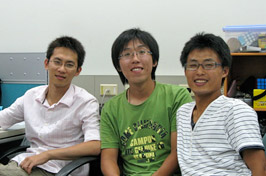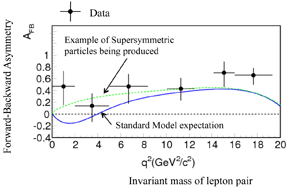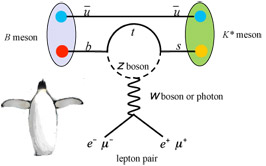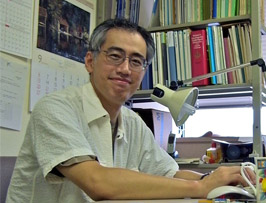 |

Jui-Te Wei (right), a physics graduate student at National Taiwan University, and his colleagues working on analysis for the Belle and LHC experiment.
|
In summer 2008, when Jui-Te Wei, a physics graduate student from National Taiwan University (NTU), saw his first plot of forward-backward asymmetry in B decay, he was not sure if he did it right. The data points came rather too high relative to the line expected from the Standard Model. He checked his analysis process for bugs, but did not find any. He shared the plot with the Belle collaborators, who approved them. The result was presented to the particles physics community in July 2008 as a good evidence for new physics beyond the Standard Model.
The process Wei was looking at is an extremely rare B decay called electroweak penguin mode. In this process, a B meson decays into a positively charged lepton, a negatively charged lepton, and a kaon in an excited state (K* meson). The K* then immediately decays into a kaon and a pion. The diagram of this process looks like a penguin with either a photon or a neutral Z boson emitted from the loop (see figure). Among many analyses that Wei had done for the decay mode, the forward-backward asymmetry was expected to exhibit a strong sign for the new physics.

The Belle's new result on the forward-backward asymmetry of the resulting leptons in the rare decay of B meson hints at the existence of new physics beyond the Standard Model. The solid blue curve represents the Standard Model expectation, the dotted green curve is one example of a supersymmetry model, and the black dots with error bars are the data.
|
 |
The forward-backward asymmetry is an asymmetry in the direction in which the positively charged lepton is emitted, with respect to the direction of the K* meson. The asymmetry parameter, A
FB, is a measure of the relative number of forward decays and backward decays. If all positively charged leptons are emitted in the forward direction, the value of A
FB would be +1. If they are all emitted in the backward direction, it is -1. If the number of forwards and backwards decays are exactly the same, then A
FB would be 0. The direction difference results from the interference between two penguin diagrams: one with an intermediate photon, and the other with an intermediate Z boson. This photon or Z boson has a virtual mass, called invariant mass, which could take quite different value from its mass in the usual sense. In the Standard Model, A
FB should be negative for small invariant mass of the intermediate particle, and positive for the larger invariant mass.
 |

Forward-backward asymmetry of the leptons with respect to the direction of K* meson is a result of the asymmetry of two leptons' momentum.
|
"The positive values for the smaller invariant mass of the intermediate particle rule out the Standard Model's prediction," explains Dr. Mikihiko Nakao of KEK, the leader of the direct CP (charge-parity) violation and rare decay group. "The data points are rather well fitted by a supersymmetry curve."
Supersymmetry, SUSY for short, is a symmetry proposed to relate two families of particles: bosons and fermions. In the Standard Model, Higgs particles and force carriers such as photons, gluons, and Z/W particles are bosons, and leptons and quarks are fermions. What distinguishes the two families of particles is a quantity called 'spin': bosons have integer values for spin, while fermions have half-integer values for spin. Physicists had made substantial efforts at finding a theoretical model that could describe symmetry between the two within the framework of the Standard Model, to no avail. So they introduced for each particle in the two families a super partner with its spin differing by one-half. Namely, every fermion has a bosonic counterpart, and vice versa. Although this symmetry theory is as old as the Standard Model, physicists have so far not found any direct evidence of SUSY.

The penguin diagram of extremely rare decay of B meson. The intermediate W and Z bosons are much heavier than the original B meson. According to the Heisenberg uncertainty principle such particles can exist only for a very short time.
|
 |
"It may be that SUSY particles are too heavy to be detected by current technology," explains Prof. Yoshi Sakai of KEK the co-spokesperson of the Belle experiment. "Yet the theory appeals to experimentalists in that it unifies three forces, namely electromagnetic, weak, and strong forces at very high energy scale."
How does the forward-backward asymmetry of
B meson decay relate to SUSY theories? These theories postulate that for every fermion or boson, a superpartner, also called a sparticle, exists. For photons, leptons, and quarks, there had to be photinos, sleptons, and squarks, at least when the universe just began with the Big Bang. Now sparticles are not seen naturally, but in processes such as
B meson decay, those sparticles briefly appear as intermediate particles, as shown in diagram (c) in the figure below. Once they have those diagrams ready in hand, physicists can calculate the possible contributions of SUSY particles to the asymmetry factors.
Though is a strong candidate for the new theory, SUSY needs to resolve significant amount of issues. "There are infinitely many models of SUSY to choose from, and even more parameters that one can use to fit our data," says Sakai. The new result ruled out those SUSY models that predicted a negative value for forward-backward asymmetry, but there are still many possible models remaining. On the experimental side, particle physicists are trying to narrow down the breadth of possible SUSY theories and other new physics theories.

In the Standard Model, either a photon or a Z boson is emitted from the loop. When supersymmetry enters the interaction, additional particles (marked with tildes), called sparticles, contribute to produce further possible interaction diagrams.
|
The Belle's original purpose, Sakai says, was to make precision measurements of CP violation predicted by the Kobayashi-Maskawa theory, which successfully predicted matter-antimatter asymmetry within the framework of the Standard Model. Belle's long accumulated data were enough to fulfill the goal.
Whatever the new theory turns out to be, physicists believe that there is something beyond the theoretical framework they currently have, simply because so many unsolved problems remain. Take one example of matter antimatter asymmetry. Why is no antimatter found in nature? CP violation in the Standard Model can account for only very small portion of CP violation necessary to create matters as we have now in our universe. Another example on theoretical side is the puzzle concerning the weak gravitational force compared to other three forces: electromagnetic, weak, and strong forces.
"Whether the SUSY is correct or not, I am interested to see how the physics theory will evolve in the future," says Wei. "I am excited about the result of our analysis on the forward-backward asymmetry, which hints that the Standard Model prediction should be modified or retuned in some way."

The direct CP violation and rare decay group leader Dr. Mikihiko Nakao of KEK has been working on the analysis of CP violations and rare decays since the beginning of the Belle experiment. He now supervises young researchers.
|
 |
There are two contributing factors to the new finding the Belle collaborators just made; the increased number of data samples, and the improved analysis technique. The extremely rare electroweak penguin-mode
B meson decay was first discovered in 2002 by the Belle group, but there were not enough samples then for the measurement of the forward-backward asymmetry. Wei used around 660 million
B and anti-
B meson pairs to obtain about 250 signal events in his analysis. He also improved his analysis by reducing systematic errors caused by lepton identification process.
"Though not a decisive one, the result is a very good indication of the new physics," says Sakai. The standard deviation is 2.7, above 99 percent accuracy. Physicists will call it a discovery when the standard deviation comes up to above 5, meaning that the finding is true with a probability of more than 99.9999 percent. "Interesting new results are coming out in other decays as well," says Nakao, "but to say anything conclusively, significantly more data are necessary."
To go to the next stage, physicists at the Belle collaboration are working full-time on the proposed upgrade, the SuperKEKB-Belle II experiment, which is proposed to start operation in 2013. The new accelerator will bring the luminosity-the rate of collisions-up to 40 times the current value. In the Belle II experiment, Sakai assures, they will be able to confirm any deviations from the Standard Model when they exist.



